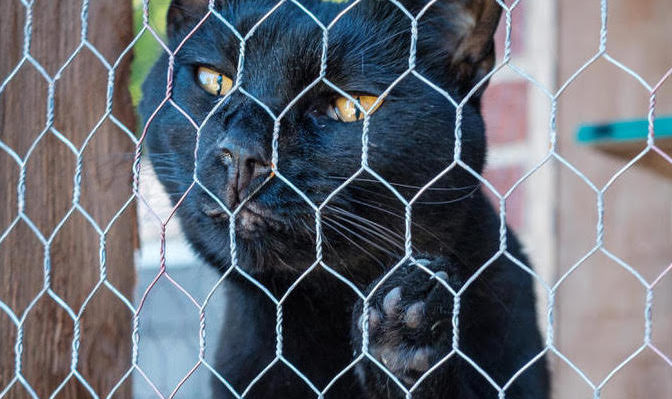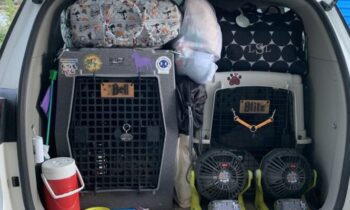
Catios—safely enclosed outdoor spaces for cats—are becoming more and more popular as increasing numbers of cat-owning households decide their feline family members will be indoor-only cats.
Steven Cogswell decided to add a catio onto his home.
Here, in his words, are why and how he chose a catio.
Steven Cogswell I live in Lakewood, Colorado, a suburb of Denver. I am the House Manager and Volunteer Usher Coordinator for the Arvada Center for the Arts and Humanities. I’ve been at the Center for almost nine years. Before that, I made my living as a performer in musical theatre and doing various odd jobs. This summer, I will be graduating from The Lang Institute of Canine Massage, after a year of study. I’m hoping to turn my garage into a canine massage studio so I can do some work out of my home.
I am guardian of four pets: three dogs and a cat, all rescues. Jett, the cat, has lived with me the longest. He came to me as a kitten seven years ago. Jasper came next. Jasper is an eight-year-old Yorkie/dachshund mix, and we’ve been together for a little over three years. Gerald and Fritz joined the clan over the past two years, both as puppies, after I had purchased a house with a big fenced yard.
I have had cats for most of my adult life. My first cats were indoor/outdoor cats because I thought that’s what you did. As I learned more about cats—especially about the vast difference in life expectancy between indoor-only cats and cats allowed outside—my cats became indoor-only cats. I knew it was better for them, but I always felt bad that their entire existence was inside. I lived in a third-floor apartment with a balcony and tried letting Jett out there for some fresh air, but the first time he jumped onto the railing, I imagined him jumping off after a bird, and we went back to indoor-only.
When I moved to a house, I fixed up the fence for the dogs, and we spent quite a bit of time in the back yard. Jett would sit by the back patio door and stare at us. It was heartbreaking; cats know how to play the guilt game! I never trusted the fence to keep Jett in the back yard, so I needed to find a way for Jett to join us and still be safe. I tried a harness, but he was able to wriggle out of it. A friend of mine “cat-proofed” their fence by adding a climb-proof header, but my yard is so big, the cost for that was prohibitive, and it didn’t seem foolproof. Also, if a critter got into the yard, they wouldn’t be able to get back out.
A catio seemed the best solution. Jett could be out on the patio with me while the dogs ran in the yard, but he would be safe so that I could relax.

Photo by Steven Cogswell
I never considered building it myself; I’m not at all handy. I did think about buying a kit and having a handyman install it.
I decided to go with a contractor because I wanted to be able to customize the catio. I had a specific area in mind, and I wasn’t able to find a kit that would work well in that space. I am trying to be careful about maintaining the value of my house, and a pieced-together solution didn’t seem worth the slight savings. My main goal was to get Jett outside, but I wanted the structure to enhance my house, too. It would be going on my back deck, which is where I entertain on the rare occasion I have guests. There is nothing fancy about my house or the back deck, but it had to look intentional and add to the ambiance.
I gravitated toward cat-centric contractors, which narrowed the field considerably. In the grand scheme of construction, catios are pretty basic, so any contractor could build one. But if I hired a generic contractor, I’d have to have a specific design in mind, and I know nothing about construction and design. I liked the idea of hiring someone who had already put some thought into what might make cats happy—someone who would supply the ideas and I could choose what I liked.
I considered the contractor who had done my friend’s fence, because he does catios as well, but I didn’t like the look of the catios on his website. Then Facebook started putting ads on my newsfeed for Cat-Topia. They were local, they offered free installation to local patrons, and they donated a portion of each sale to the Dumb Friends League, the animal shelter where I volunteer. They had pre-fabricated catios as well as the option to have a custom catio . . . for which they offered a free consultation. When I put all of that together, they seemed like the right choice.
I liked that their website had prices on the page. (I hate not knowing the ballpark cost for something. I didn’t want to schedule an estimator to come out just to find out there’s no way I could afford it.) The pre-fabricated catios had quite a price range, from $1,000 to $7,500. For custom catios, they gave an estimate of $55 per square foot with an average size of 40 square feet. This was the general information I needed. I figured with a single cat, a smaller catio would be perfect. I set my budget to no more than $2,000. Initially, I was hoping to spend no more than $800, but after my research, the higher price seemed reasonable. I would be getting a custom design, professionally installed.
After looking at the space, the owner of Cat-Topia thought one of his pre-fabricated options would work nicely. I had seen the plans online; it was the catio I liked best, so we decided to go with it. He altered the dimensions of it slightly to fit my space, but the basic design was the same as the pre-fabricated catio. They have two versions, one with a roof and one without. We decided to go with the roof to keep out the rain and snow. Going with a customized pre-fabricated catio saved me some cash, coming in at $1,300 installed. I was pleased that he didn’t try to up-sell me to something more than I needed.
I don’t have any trees in the backyard, so the afternoon sun can get pretty intense on the patio. I don’t imagine Jett will be out during the heat of the day in the summer months, but our winters in Colorado are all over the place. We have warm, sunny days followed by bitter cold blizzards. I think Jett will use it on the nicer days and stay inside with the rest of us when it gets cold. I suspect for 85% of the year, the weather will be catio friendly.
They sent out a two-person crew. The crew arrived around 10:00 a.m. with all the materials, and it took them about four to five hours to install. Their cleanup was as thorough as their building.

Photo by Steven Cogswell
They screwed the catio directly into the wood deck of my patio. It is tight against the house, but not attached to the house in any way. An added bonus is that Cat-Topia offers a deconstruction service if I move. They’ll dismantle it and ship it to my new home.
It was important to me that the catio didn’t drastically alter the house. If I decide to sell, some buyers might not be as excited about a catio as I am. Watching the crew build it, I was confident in my decision to have it professionally installed. It is not something I could have done.
The building process wasn’t that disruptive. The dogs had to stay inside so they didn’t bother the crew. Jett wasn’t sure what was going on, but he figured out it had something to do with him, so he hung out in the back room and watched. I took the dogs for individual walks about halfway through the build so they could work off some of the stress of having strangers in their back yard.
I think the new catio is going to work out splendidly!
At first, Jett was pretty skeptical. Even though he uses a cat door to get to his litter box (we had to put it in a closet to keep the dogs away), it took him several hours to figure out how to enter the catio. Once Jett realized he could come and go as he pleased, he was more into it.
For the first few days, he would go out only when the dogs and I were out. But lately, he’s going out on his own. We have to spruce it up more for him, with some soft surfaces and maybe something to climb on, so it’s more comfortable and exciting. I think he’s still frustrated that he can’t get out into the yard, but I do think he feels more a part of things. I know he loves the sun and the fresh air.
I think the most significant advantage is the autonomy the catio gives Jett. Living with three dogs is a lot. I have a 1950s ranch-style home, so there aren’t any vaulted ceilings with high shelves for Jett to escape to. He deals with the dogs well, but I could see that his not being able to get away from them was causing him some stress. The catio is entirely his, he can go there whenever he wants, and I think that is huge for him. He’s a social cat and will probably choose to be with us most of the time, but I can already see a reduction in his stress now that he has a no-dog zone.
I would recommend catios. I can’t say it’s the most cost-effective decision I’ve ever made; it was more than I originally wanted to spend. Someone with more ingenuity and skill than I possess could easily build something just as nice for much less. But I think it is an effective way to break up the monotony of indoor life. Cats need a change of scenery and mental stimulation, as all living creatures do. Now Jett can smell the smells and see how the seasons change without the risk of being carried off by a coyote. It’s a compromise, really, and does nothing to change the fact that Jett lives in captivity, but I do think it makes his life richer.
I’m glad catios are becoming popular. It’s always been a tough talk to have with people who let their cats outside, finding a way to tell them that isn’t off-putting that I don’t believe it’s good for their cat’s welfare. Now, I can explain why my cat has a catio: I don’t let him outside because I want him with me for a long time . . . but he has this cool place of his own.



